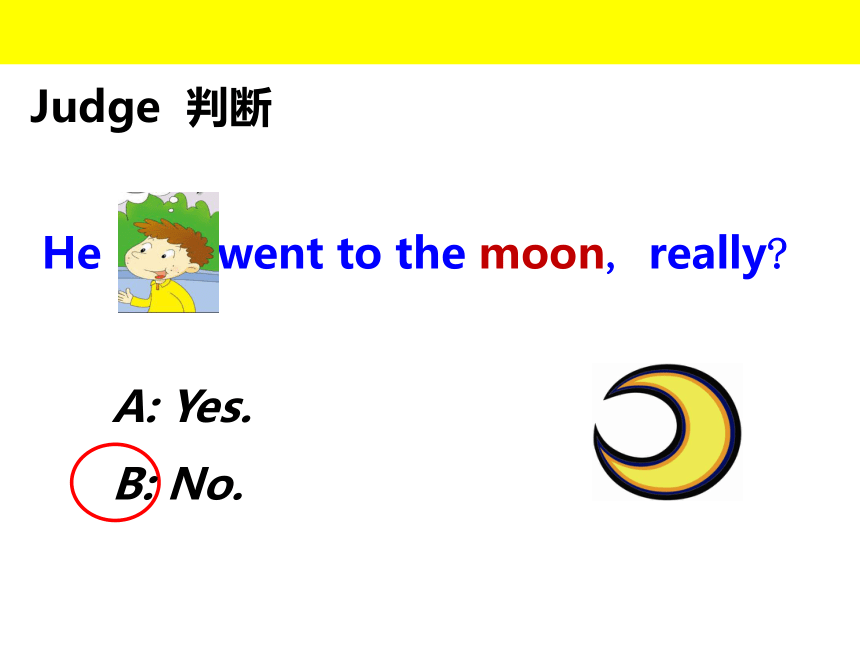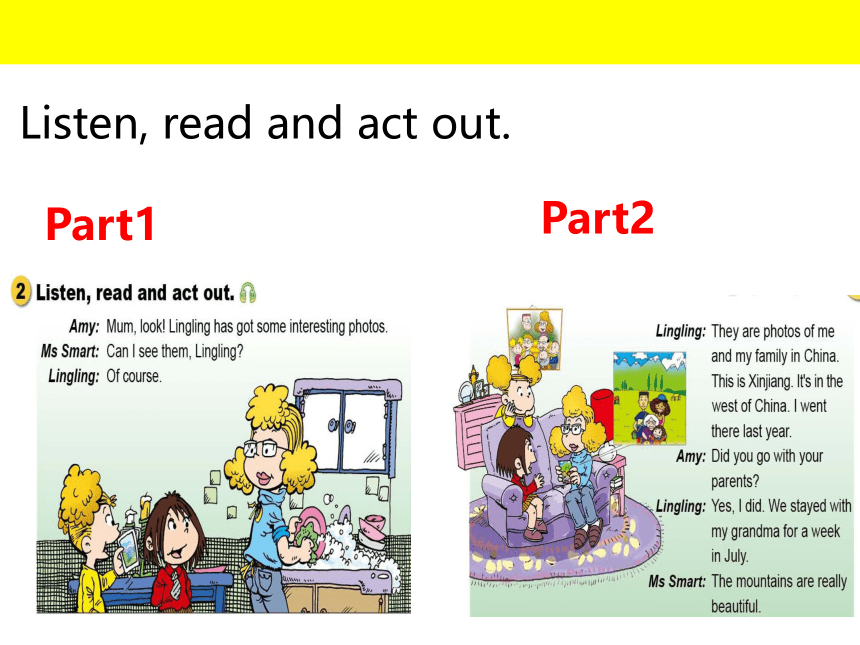Unit 1 I went there last year 课件
文档属性
| 名称 | Unit 1 I went there last year 课件 |  | |
| 格式 | zip | ||
| 文件大小 | 6.9MB | ||
| 资源类型 | 教案 | ||
| 版本资源 | 外研版(三年级起点) | ||
| 科目 | 英语 | ||
| 更新时间 | 2018-05-17 10:34:55 | ||
图片预览












文档简介
课件31张PPT。Module 6
Unit 1 I went there last year.看一看,听一听和说一说
A : Where did you go for the holidays?
你假期去了哪里?
B : I went to the moon.
我去了月球。
A : The moon? How did you get there?
月球?你怎样到达那里的?
B : I used my computer . Ha ha...
我使用了我的电脑。哈哈……He went to the moon, really?A: Yes.
B: No.Judge 判断
问:你去了什么什么地方?句型一:where did you go …. ?句型三:How did you get there ?答:我去到了那里….句型二: I go/went to ….问:你怎么去的/你是如何去那里的?你妈妈怎样去上班?How does your mother go to work?She goes to work by bike . 她犄自行车去上班。重点:在对交通方式提问时要用特殊疑问词 how【即学即用】
- _________ does your father go to work?
-By car.
A.How B.What C.WhenGet /get/v.(动词)到达
短语:get up起床
例句:When did you get to Shanghai?
你什么时候到达上海的?
现在分词:getting
过去式:gotMoon / mu : n /n.(名词)月亮,月球
短语:a bright moon -轮明月
例句:I want to fly to the moon.
我想飞向月球。get的用法
get作及物动词时,一般意为“得到,获得”
后面跟宾语。例如:
He got the new pen.他得到了那支新钢笔。
get作不及物动词时,经常与介词构成短语,如:
get on(上车),get up(起床),get to(到达),
get off(下车)等。例如:
What time do you get up?你什么时间起床?
注意: get to后面跟副词时需省略to。例如:
How did you get here?你是怎样到达这里的?Part1Part2Listen, read and act out.1.When did Lingling go to Xinjiang? A:She went there last year.
B: She went there in June. 2.Did she go with her parents?Yes, she did.It’s in the ______ of China. north(北)west(西)east(东)south(南)west一、some的用法及辨析picture与photo
例句:Lingling has got some interesting photos.玲玲有一些有趣的照片。
some的用法
some表示“一些”,既可以修饰可数名词,也可以修饰不可数名词.
在表示建议、反问、请求的疑问句中,多用some。例如:
There are some books on the desk.桌上有一些书。
There is some milk in the bottle.瓶子里有一些牛奶。
Would you like some bread?你想吃些面包吗?辨picture与photo
picture与photo都有“相片、照片”的含义
但是picture是广义的图片,指各类形式的图片统称,有图片、图画,当然也包括照片。
photo是指通过摄影或摄影器材拍摄得到的照片。例如:
There is a photo of my grandparents on the wall.
墙上有一张我爷爷和奶奶的照片。
There is a picture on the wall.墙上有一幅图画。photopicture【即学即用】
This is a____ of my family.
A. pictures B.photo C.drawingcan与them的用法
例句:Can I see them,Lingling?我可以看看它们吗,玲玲?
can的用法
can是情态动词,没有人称和数的变化,不能单独在句中作谓语,必须与后面的动词原形构成谓语。其基本用法如下:
表示能力,意为“能,会”。例如:
Her sister speak English.她的姐姐会说英语。
I sing English songs.我会唱英文歌曲。
表示请求或许可。例如:
Can I help you?我能帮助你吗?
表示推测,意为“也许,可能”。例如:
He can't be your brother.他不可能是你的哥哥。cancan【即学即用】
The man____see. He is blind(盲的,瞎的).
A. can B.can't C.couldn'tthem的用法
them是宾格,主格是they,人称代词的用法如下:
1 .人称代词的主格在句中充当主语。例如:
I am a teacher.我是一名教师。
2 .人称代词的宾格在句子中充当动词的宾语、介词宾语或表语等。例如:
Give it to me.把它给我。3.Of course.当然(可以)。
of course意为“当然(可以)”,在口语中经常出现,
与单词“sure“的意思相同。主要用法有:
在对话中作肯定回答。例如:
- Can I use your bike,please?请问我可以用你的自行车吗?
与not连用,强调不同意,意为“当然不”。例如:
Are you feeling tired?你觉得累吗?
-Of course______ 当然不(累)。
Of course.当然(可以)not 4.They are photos of me and my family in China
它们是我和我的家人在中国的照片。
of的用法总结如下:
表示所有关系。例如:
This is a picture of our classroom.这是我们的教室的一张图片。
用于表示计量、时间或年龄。例如:
two kilos of potatoes 2千克马铃著
a girl of twelve -个12岁的女孩
选择:Beijing is in the north ____China.
A. to B.of C.about提问:这里的of 属于哪一种用法呢
It's in the west of China.它在中国的西部。
要表达某地在某国(省、市)内的某个方位,
要用“in the+方位+of+国名(省名、市名)”结构,是所属关系。
课文中已经有例子了,再看两个例子:
Shandong is in the east of China.山东在中国的东部。
Qingdao is in the east of Shandong.青岛在山东的东部。
生活应用:
Daming的英国朋友John要来中国旅游,
John希望Daming给他提供几座著名的旅游城市,
Daming对著名的旅游城市海南、桂林、杭州等做了介绍。
John想知道桂林在中国的方位。John会怎么问?
Daming又是怎样回答呢!-Where is Guilin?桂林在哪里?
-lt's in the south of China.它在中国的南部。
六、with的用法
6.Did you go with your parents?你是和你的父母一起去的吗?
with是介词,用法多变,主要有以下几种用法:
与……一起。例如:
Lingling lives with her grandmother.玲玲与她的奶奶住在一起。
带着……,有……的。例如:
The girl with long hair is my sister.留着长头发的女孩是我的姐姐。
表示手段、材料,用(工具)。例如:
My American friend is learning to eat with chopsticks.
我的美国朋友正在学习用筷子吃饭。
在身边,在……身上。例如:
I have no money with me.我身上没有钱。
【即学即用】
I often go to school ______ Li Ming.
A. and B.with C.for七.for的用法
7.We stayed with my grandma for a week in July.
在七月,我们和我的奶奶在一起待 了一个星期。
for的用法很多,常见的用法主要有以下几种:
(表示时间、距离、数量等)达;记。例如:
We have stayed here for two months.我们已在这儿待两个月了。
(表示目的、用途)为了;供。例如:
He went out for a walk.他出去散步了。
(表示对象)为,给;对于;关于;至于,对……而言。例如:
Watching TV too much is bad for your health.看电视太多对你的健康有害。
(表示目标、去向)往;到……。例如:
Is this train for Shanghai?这是开往上海的火车吗?They have walked _____two hours.
A. of B.to C.for八、really的用法
8.The mountains are really beautiful.这些山真美。
really的用法:
Q表示“真正地,真实地”。例如:
She really said she didn't come.她真说她不来了。
表示“很;十分”。例如:
It's really cold today.今天很冷。
表示“确实,的确”。例如:
I really must go.我确实得走了。【即学即用】
Mountain zhumulangma is ___ high.
A. really B.real C.ready8848米
世界最高峰Part 3It's Lingling's uncle.3、Who is the man?2、Where is Hainan? It's in the _______of China. 1、Where did Lingling go? She went to Hainan.southThey are Li people(黎族).There are 56 peoples in our country.
我们国家有56个民族。We are a big family.
我们是一个大家庭。people作集合名词“人,人民”讲时,
单复数相同
people意为 “民族、种族”时,复数为 peoples。
There are five people in my family.我家有五口人。
[即学即用】
How many___ in your family?
A. peoples B . people C . man
Unit 1 I went there last year.看一看,听一听和说一说
A : Where did you go for the holidays?
你假期去了哪里?
B : I went to the moon.
我去了月球。
A : The moon? How did you get there?
月球?你怎样到达那里的?
B : I used my computer . Ha ha...
我使用了我的电脑。哈哈……He went to the moon, really?A: Yes.
B: No.Judge 判断
问:你去了什么什么地方?句型一:where did you go …. ?句型三:How did you get there ?答:我去到了那里….句型二: I go/went to ….问:你怎么去的/你是如何去那里的?你妈妈怎样去上班?How does your mother go to work?She goes to work by bike . 她犄自行车去上班。重点:在对交通方式提问时要用特殊疑问词 how【即学即用】
- _________ does your father go to work?
-By car.
A.How B.What C.WhenGet /get/v.(动词)到达
短语:get up起床
例句:When did you get to Shanghai?
你什么时候到达上海的?
现在分词:getting
过去式:gotMoon / mu : n /n.(名词)月亮,月球
短语:a bright moon -轮明月
例句:I want to fly to the moon.
我想飞向月球。get的用法
get作及物动词时,一般意为“得到,获得”
后面跟宾语。例如:
He got the new pen.他得到了那支新钢笔。
get作不及物动词时,经常与介词构成短语,如:
get on(上车),get up(起床),get to(到达),
get off(下车)等。例如:
What time do you get up?你什么时间起床?
注意: get to后面跟副词时需省略to。例如:
How did you get here?你是怎样到达这里的?Part1Part2Listen, read and act out.1.When did Lingling go to Xinjiang? A:She went there last year.
B: She went there in June. 2.Did she go with her parents?Yes, she did.It’s in the ______ of China. north(北)west(西)east(东)south(南)west一、some的用法及辨析picture与photo
例句:Lingling has got some interesting photos.玲玲有一些有趣的照片。
some的用法
some表示“一些”,既可以修饰可数名词,也可以修饰不可数名词.
在表示建议、反问、请求的疑问句中,多用some。例如:
There are some books on the desk.桌上有一些书。
There is some milk in the bottle.瓶子里有一些牛奶。
Would you like some bread?你想吃些面包吗?辨picture与photo
picture与photo都有“相片、照片”的含义
但是picture是广义的图片,指各类形式的图片统称,有图片、图画,当然也包括照片。
photo是指通过摄影或摄影器材拍摄得到的照片。例如:
There is a photo of my grandparents on the wall.
墙上有一张我爷爷和奶奶的照片。
There is a picture on the wall.墙上有一幅图画。photopicture【即学即用】
This is a____ of my family.
A. pictures B.photo C.drawingcan与them的用法
例句:Can I see them,Lingling?我可以看看它们吗,玲玲?
can的用法
can是情态动词,没有人称和数的变化,不能单独在句中作谓语,必须与后面的动词原形构成谓语。其基本用法如下:
表示能力,意为“能,会”。例如:
Her sister speak English.她的姐姐会说英语。
I sing English songs.我会唱英文歌曲。
表示请求或许可。例如:
Can I help you?我能帮助你吗?
表示推测,意为“也许,可能”。例如:
He can't be your brother.他不可能是你的哥哥。cancan【即学即用】
The man____see. He is blind(盲的,瞎的).
A. can B.can't C.couldn'tthem的用法
them是宾格,主格是they,人称代词的用法如下:
1 .人称代词的主格在句中充当主语。例如:
I am a teacher.我是一名教师。
2 .人称代词的宾格在句子中充当动词的宾语、介词宾语或表语等。例如:
Give it to me.把它给我。3.Of course.当然(可以)。
of course意为“当然(可以)”,在口语中经常出现,
与单词“sure“的意思相同。主要用法有:
在对话中作肯定回答。例如:
- Can I use your bike,please?请问我可以用你的自行车吗?
与not连用,强调不同意,意为“当然不”。例如:
Are you feeling tired?你觉得累吗?
-Of course______ 当然不(累)。
Of course.当然(可以)not 4.They are photos of me and my family in China
它们是我和我的家人在中国的照片。
of的用法总结如下:
表示所有关系。例如:
This is a picture of our classroom.这是我们的教室的一张图片。
用于表示计量、时间或年龄。例如:
two kilos of potatoes 2千克马铃著
a girl of twelve -个12岁的女孩
选择:Beijing is in the north ____China.
A. to B.of C.about提问:这里的of 属于哪一种用法呢
It's in the west of China.它在中国的西部。
要表达某地在某国(省、市)内的某个方位,
要用“in the+方位+of+国名(省名、市名)”结构,是所属关系。
课文中已经有例子了,再看两个例子:
Shandong is in the east of China.山东在中国的东部。
Qingdao is in the east of Shandong.青岛在山东的东部。
生活应用:
Daming的英国朋友John要来中国旅游,
John希望Daming给他提供几座著名的旅游城市,
Daming对著名的旅游城市海南、桂林、杭州等做了介绍。
John想知道桂林在中国的方位。John会怎么问?
Daming又是怎样回答呢!-Where is Guilin?桂林在哪里?
-lt's in the south of China.它在中国的南部。
六、with的用法
6.Did you go with your parents?你是和你的父母一起去的吗?
with是介词,用法多变,主要有以下几种用法:
与……一起。例如:
Lingling lives with her grandmother.玲玲与她的奶奶住在一起。
带着……,有……的。例如:
The girl with long hair is my sister.留着长头发的女孩是我的姐姐。
表示手段、材料,用(工具)。例如:
My American friend is learning to eat with chopsticks.
我的美国朋友正在学习用筷子吃饭。
在身边,在……身上。例如:
I have no money with me.我身上没有钱。
【即学即用】
I often go to school ______ Li Ming.
A. and B.with C.for七.for的用法
7.We stayed with my grandma for a week in July.
在七月,我们和我的奶奶在一起待 了一个星期。
for的用法很多,常见的用法主要有以下几种:
(表示时间、距离、数量等)达;记。例如:
We have stayed here for two months.我们已在这儿待两个月了。
(表示目的、用途)为了;供。例如:
He went out for a walk.他出去散步了。
(表示对象)为,给;对于;关于;至于,对……而言。例如:
Watching TV too much is bad for your health.看电视太多对你的健康有害。
(表示目标、去向)往;到……。例如:
Is this train for Shanghai?这是开往上海的火车吗?They have walked _____two hours.
A. of B.to C.for八、really的用法
8.The mountains are really beautiful.这些山真美。
really的用法:
Q表示“真正地,真实地”。例如:
She really said she didn't come.她真说她不来了。
表示“很;十分”。例如:
It's really cold today.今天很冷。
表示“确实,的确”。例如:
I really must go.我确实得走了。【即学即用】
Mountain zhumulangma is ___ high.
A. really B.real C.ready8848米
世界最高峰Part 3It's Lingling's uncle.3、Who is the man?2、Where is Hainan? It's in the _______of China. 1、Where did Lingling go? She went to Hainan.southThey are Li people(黎族).There are 56 peoples in our country.
我们国家有56个民族。We are a big family.
我们是一个大家庭。people作集合名词“人,人民”讲时,
单复数相同
people意为 “民族、种族”时,复数为 peoples。
There are five people in my family.我家有五口人。
[即学即用】
How many___ in your family?
A. peoples B . people C . man
同课章节目录
- Module 1
- Unit 1 We lived in a small house.
- Unit 2 She didn't have a television.
- Module 2
- Unit 1 She learnt English.
- Unit 2 Mr Li was a teacher.
- Module 3
- Unit 1 She had eggs and sausages.
- Unit 2 Sam ate four hamburgers.
- Module 4
- Unit 1 Let's make a home library.
- Unit 2 We can find information from books and CDs.
- Module 5
- Unit 1 It's big and light.
- Unit 2 It's too big for you.
- Module 6
- Unit 1 I went there last year.
- Unit 2 She visited the Tianchi Lake.
- Module 7
- Unit 1 My father goes to work at eight o'clock eve
- Unit 2 I'll be home at seven o'clock.
- Module 8
- Unit 1 Will you help me?
- Unit 2 I made a kite.
- Module 9
- Unit 1 We laughed a lot.
- Unit 2 Mum bought new T-shirts for you.
- Module 10
- Unit 1 Where are you going to go?
- Unit 2 I'm in New York now.
- Review Module
- Unit 1
- Unit 2
